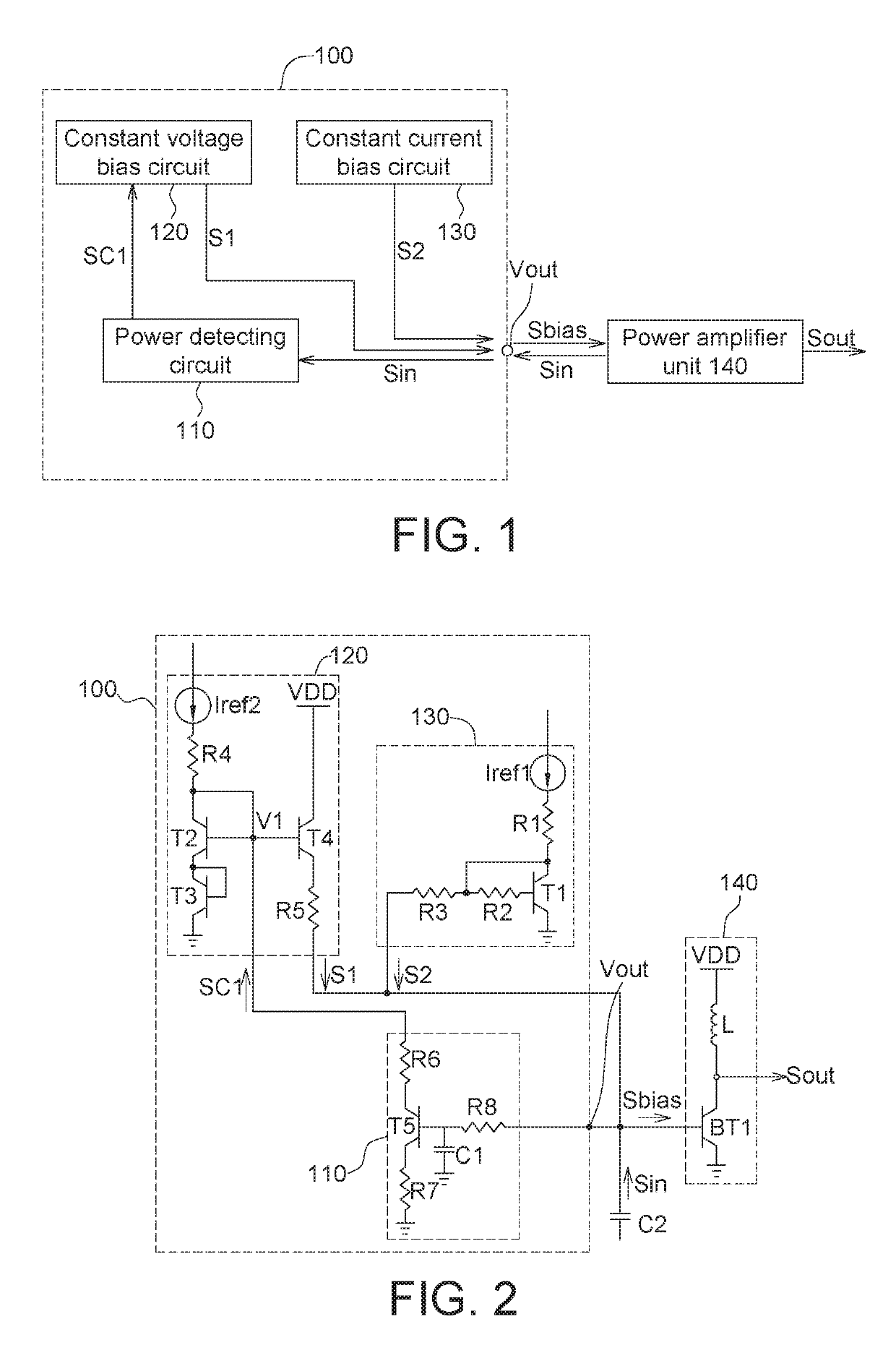Bias circuit and power amplifier circuit
a power amplifier circuit and bias technology, applied in amplifiers, amplifier types, amplifiers with semiconductor devices/discharge tubes, etc., can solve the problems of distorted output signals and drop in linearity of power amplifier circuits
- Summary
- Abstract
- Description
- Claims
- Application Information
AI Technical Summary
Benefits of technology
Problems solved by technology
Method used
Image
Examples
first embodiment
[0013]FIG. 1 shows a block diagram of a bias circuit 100 according to the present disclosure. The bias circuit 100 includes an output node Vout, a power detecting circuit 110, a constant voltage bias circuit 120, and a constant current bias circuit 130. The output node Vout is configured to provide a bias signal Sbias to a power amplifier unit 140 and receive an input signal Sin of the power amplifier unit 140. The power detecting circuit 110 detects a power of the input signal Sin of the power amplifier unit 140 to provide a control signal SC1. The constant voltage bias circuit 120 is configured to selectively provide a first signal S1 to the output node Vout according to control signal SC1. The constant current bias circuit 130 provides a second signal S2 to the output node Vout.
[0014]In the present disclosure, the power amplifier unit 140 generates an output signal Sout according to the input signal Sin, such as a radio frequency signal. The power detecting circuit 110 detects a ...
second embodiment
[0024]FIG. 5 shows a circuit diagram of a bias circuit 200 according to the present disclosure. The bias circuit 200 of FIG. 5 is different from the bias circuit 100 of FIG. 2 in that the bias circuit 200 further includes another constant voltage bias circuit 150. The circuit structure of the constant voltage bias circuit 150 is identical to the circuit structure of the constant voltage bias circuit 120, and the similarities are not repeated here. In the present embodiment, the power detecting circuit 210 of FIG. 5 further provides a control signal SC2 to the constant voltage bias circuit 150 according to the power of the input signal Sin of the power amplifier unit 140 and makes the constant voltage bias circuit 150 selectively provide a third signal S3 to the output node Vout of the bias circuit 200 according to the control signal 502.
[0025]In the present embodiment, the power detecting circuit 210 of FIG. 5 is different from the power detecting circuit 110 of FIG. 2 in that the p...
PUM
 Login to View More
Login to View More Abstract
Description
Claims
Application Information
 Login to View More
Login to View More - R&D
- Intellectual Property
- Life Sciences
- Materials
- Tech Scout
- Unparalleled Data Quality
- Higher Quality Content
- 60% Fewer Hallucinations
Browse by: Latest US Patents, China's latest patents, Technical Efficacy Thesaurus, Application Domain, Technology Topic, Popular Technical Reports.
© 2025 PatSnap. All rights reserved.Legal|Privacy policy|Modern Slavery Act Transparency Statement|Sitemap|About US| Contact US: help@patsnap.com



